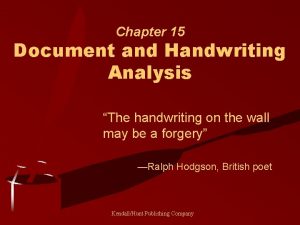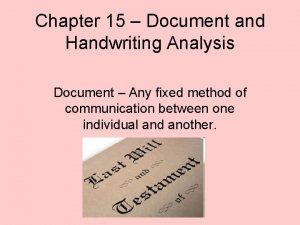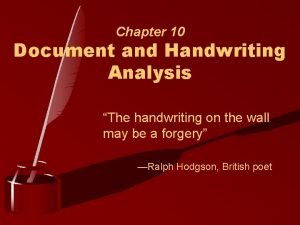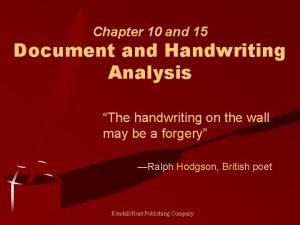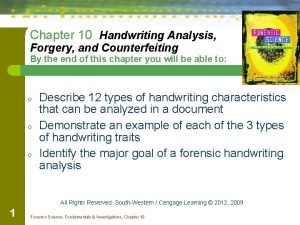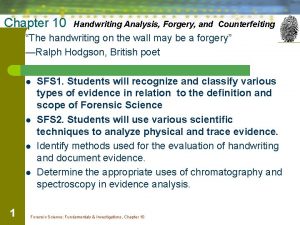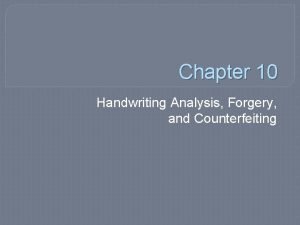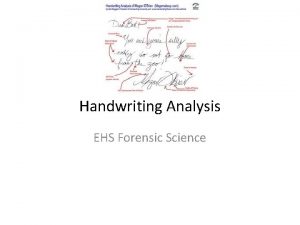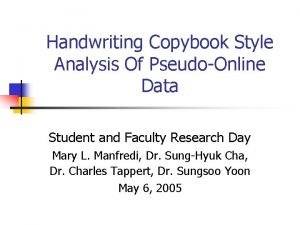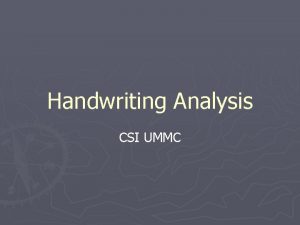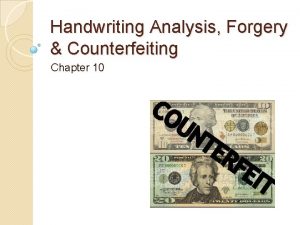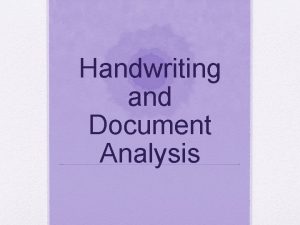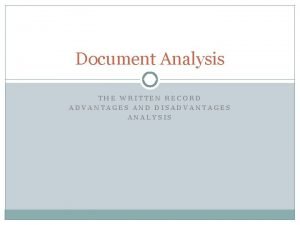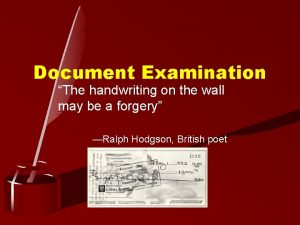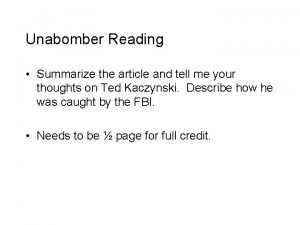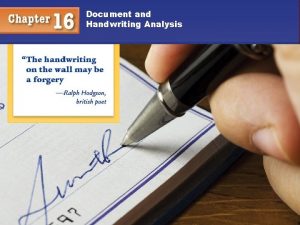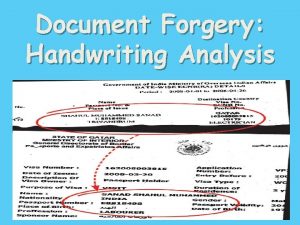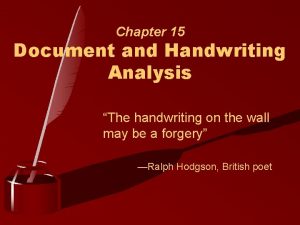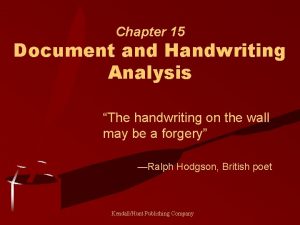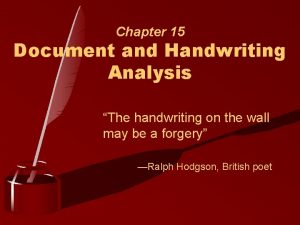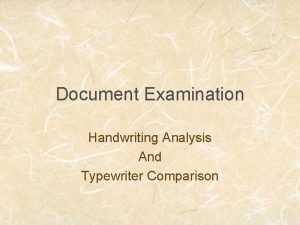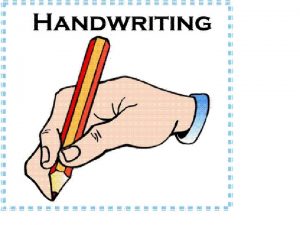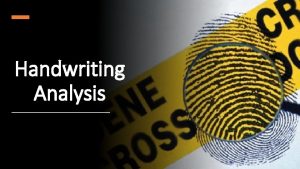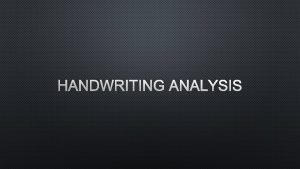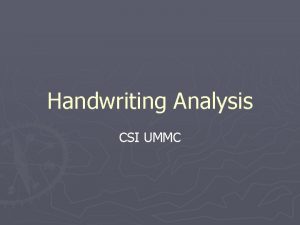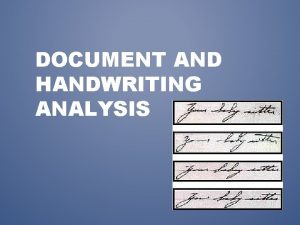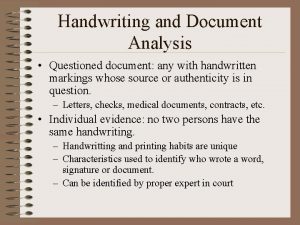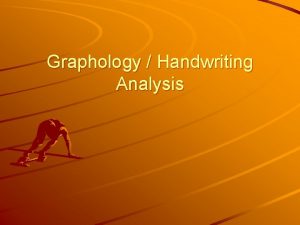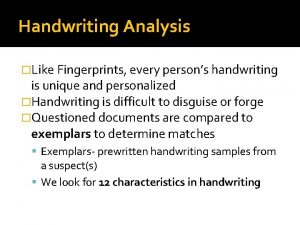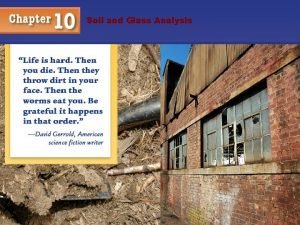Chapter 10 Document and Handwriting Analysis The handwriting
































- Slides: 32

Chapter 10 Document and Handwriting Analysis “The handwriting on the wall may be a forgery” —Ralph Hodgson, British poet

FORGERY = Items prepared with intent to deceive. EXEMPLAR = The confirmed example that suspected forgeries are compared against Chapter 15 Kendall/Hunt Publishing Company 1

What can be forged? § Checks § Counterfeit § Alterations § Money § Credit Cards § Theft of card or number § Art § Paper § Contracts § Coin § Wills § Identities § medical records § Passports § Social Security § Drivers license Chapter 15 2

How are forgeries discovered? § Must be compared against an exemplar or § An abnormality arises § 2 checks with the same serial number § Ink mysteriously starts running § Paper used is different Chapter 15 3

Who confirms forgeries? )CIA (USA) )FBI (USA) )SCOTLAND YARD (UK) Chapter 15 4

Punishment forgeries? )first degree – felony – presentation/use of forged items )second degree – felonypossession with intent to use )third degree – misdemeanor – complicity with forger Chapter 15 5

Related Fields § Historical Dating—the verification of age and value of a document or object § Fraud Investigation—focuses on the money trail and criminal intent § Paper and Ink Specialists—date, type, source, and/or catalogue various types of paper, watermarks, ink, printing/copy/fax machines, computer cartridges § Forgery Specialists—analyze altered, obliterated, changed, or doctored documents and photos § Typewriting Analysts—determine origin, make, and models § Computer Crime Investigators—investigate cybercrime Chapter 15 6

Handwriting Chapter 15 Kendall/Hunt Publishing Company 7

The 12 Handwriting Characteristics (#1 -6) 1. Line Quality –are letters erratic or shaky 2. Word and Letter Spacing – spaced or crowded 3. Size consistency – compares ratio of height to width 4. Continuous - pen lifts or continuous writing 5. Connecting letters – are capitals and lower-case letters connected and continuous 6. Letters complete – are letters fully written or partially Chapter 15 8

The 12 Handwriting Characteristics (#7 -12) 7. Cursive/Printed – cursive printed or both (when) 8. Pen Pressure – equal ^ and V strokes 9. Slant – left, right, variable, no slant? 10. Line Habits – above line, below line, on line? 11. Flourishes or Embellishments – fancy curls? 12. Diacritic Placement – correct, misplaced, t’s crossed towards top/bottom, i’s dotted? Dotted to the right/left/centered? Chapter 15 9

Handwriting Identification § The document examiner must have enough exemplars to make a determination of whether or not the two samples match. Chapter 15 10

How to get a Handwriting sample § The tested subject should: § not be shown the questioned document § not be told how to spell words or use punctuation § use materials similar to those used in the original document § be asked to sign the text § always have a witness Chapter 15 11

Methods of Handwriting Forgery § Simulated forgery—one made by copying an exemplar § Traced forgery—one made by tracing an exemplar § Blind forgery—made without an exemplar Chapter 15 12

Handwriting Doesn’t violate th 5 amendement - Right not to self-incriminate Chapter 15 Kendall/Hunt Publishing Company 13

Famous Forgers and Forgeries § Major George Byron (Lord Byron forgeries) § Thomas Chatterton (Literary forgeries) § John Payne Collier (Printed forgeries) § Dorman David (Texas Declaration of Independence) § Mark Hofmann (Mormon, Freemason forgeries) § William Henry Ireland (Shakespeare forgeries) § Clifford Irving (Howard Hughes forgery) § Konrad Kujau (Hitler Diaries) § James Macpherson (Ossian manuscript) § George Psalmanasar (Literary forgery) § Alexander Howland Smith (Historical documents) Chapter 15 Kendall/Hunt Publishing Company 14

Graphology )“Pseudoscience” (fake science) that determines personality based on characteristics of handwriting Chapter 15 Kendall/Hunt Publishing Company 15

Ink Chromatography is a method of physically separating the components of inks Types § HPLC—high-performance liquid chromatography § TLC—thin-layer chromatography § Paper Chromatography Chapter 15 Kendall/Hunt Publishing Company 16

Paper Chromatography of Ink Two samples of black ink from two different manufacturers have been characterized using paper chromatography. Chapter 15 Kendall/Hunt Publishing Company 17

Retention Factor (Rf) § A number that represents how far a compound travels in a particular solvent § It is determined by measuring the distance the compound traveled and dividing it by the distance the solvent traveled.

3 FACTORS TO CONSIDER WHEN ANALYZING INK CHROMATOGRAPHY 1. SOLVENT 2. INK 3. PAPER Chapter 15 Kendall/Hunt Publishing Company 19

Paper Differences § § § § Raw material Weight Density Thickness Color Watermarks Age Fluorescence Chapter 15 Making paper Kendall/Hunt Publishing Company 20

Pencils Hardness Scale—a traditional measure of the hardness of the "leads" (actually made of graphite) in pencils. § The hardness scale, from softer to harder, takes the form. . . , 3 B, 2 B, B, HB, F, H, 2 H, 3 H, 4 H, . . . , with the standard "number 2" pencil being of hardness 2 H. Chapter 15 Kendall/Hunt Publishing Company 21

Evidence § Class characteristics may include general types of pens, pencils or paper. § Individual characteristics may include unique, individual handwriting characteristics; trash marks from copiers, or printer serial numbers. Chapter 15 Kendall/Hunt Publishing Company 22

Counterfeiting ) The Secret Service was created in 1865 to combat counterfeiting by Abe Lincoln ) In 1996 the government starting adding new security features to make incidences of counterfeiting more difficult. Chapter 15 Kendall/Hunt Publishing Company 23

DISTINGUISHING FROM COUNTERFIT Chapter 15 Kendall/Hunt Publishing Company 24

$ AT THE CHEKOUT COUNTER • How $ is Tested • Iodine solution pen )Pass )Turns yellow Chapter 15 )Fail )Black or dark brown Kendall/Hunt Publishing Company 25

Chapter 15 Kendall/Hunt Publishing Company 26

Chapter 15 Kendall/Hunt Publishing Company 27

4 th amendment )The right of the people to be secure in their persons, houses, papers, and effects, against unreasonable searches and seizures, shall not be violated, and no Warrants shall issue, but upon probable cause, supported by Oath or affirmation, and particularly describing the place to be searched, and the persons or things to be seized. Chapter 15 Kendall/Hunt Publishing Company 28

More about Document Analysis For additional information about document and handwriting analysis, check out Court TV’s Crime Library at: lwww. crimelibrary. com/criminal_mind/forensics/literary/1. htm Or forgery cases at: www. crimelibrary. com/criminal_mind/scams/lincoln_forgers/index. html Chapter 15 Kendall/Hunt Publishing Company 29

Types of Evidence • class • individual Chapter 15 • class • individual

Types of Evidence ) direct evidence – Creates a directly link to a crime ) statements of witness, video footage, audio tape, a confession, etc. ) Circumstantial evidence – indirect connection to a crime ) physical evidence – shoe prints, tire impressions, tool marks, fibers from clothing, shell casings, etc … ) biological evidence – body fluids, hair, plant parts, natural fibers Chapter 15
 Chapter 15 document and handwriting analysis
Chapter 15 document and handwriting analysis Document
Document Mormon and freemason forgeries
Mormon and freemason forgeries Chapter 15 document and handwriting analysis
Chapter 15 document and handwriting analysis Chapter 10 handwriting analysis forgery and counterfeiting
Chapter 10 handwriting analysis forgery and counterfeiting Baseline habits handwriting
Baseline habits handwriting Chapter 10 handwriting analysis forgery and counterfeiting
Chapter 10 handwriting analysis forgery and counterfeiting Forensic handwriting analysis video
Forensic handwriting analysis video Handwriting analysis forgery and counterfeiting
Handwriting analysis forgery and counterfeiting Document.write(document.cookie)
Document.write(document.cookie) Handwriting analysis online scan
Handwriting analysis online scan Analysis handwriting
Analysis handwriting Placement of diacritics is examining
Placement of diacritics is examining Computerized analysis of handwriting
Computerized analysis of handwriting The 12 characteristics of handwriting
The 12 characteristics of handwriting Handwriting analysis lab answers
Handwriting analysis lab answers Document expert definition
Document expert definition Running record advantages and disadvantages
Running record advantages and disadvantages Clipchp
Clipchp Writing above the line
Writing above the line Flourishes and embellishments in handwriting
Flourishes and embellishments in handwriting Hát kết hợp bộ gõ cơ thể
Hát kết hợp bộ gõ cơ thể Bổ thể
Bổ thể Tỉ lệ cơ thể trẻ em
Tỉ lệ cơ thể trẻ em Gấu đi như thế nào
Gấu đi như thế nào Tư thế worm breton
Tư thế worm breton Hát lên người ơi
Hát lên người ơi Các môn thể thao bắt đầu bằng tiếng chạy
Các môn thể thao bắt đầu bằng tiếng chạy Thế nào là hệ số cao nhất
Thế nào là hệ số cao nhất Các châu lục và đại dương trên thế giới
Các châu lục và đại dương trên thế giới Cong thức tính động năng
Cong thức tính động năng Trời xanh đây là của chúng ta thể thơ
Trời xanh đây là của chúng ta thể thơ
